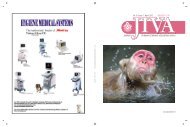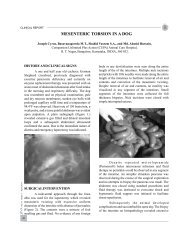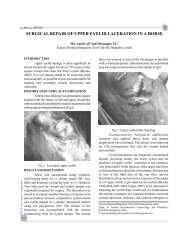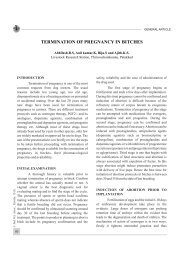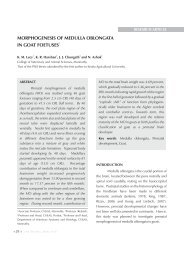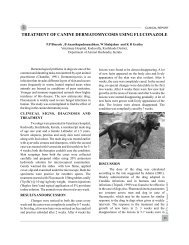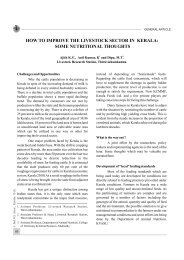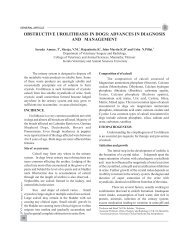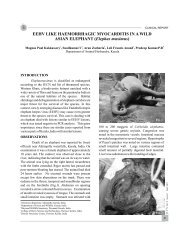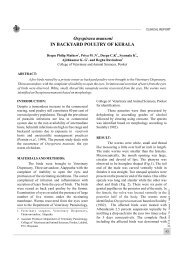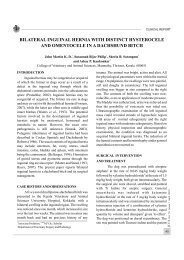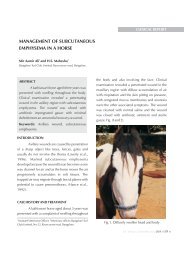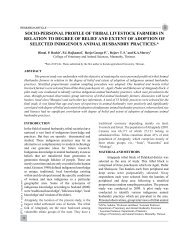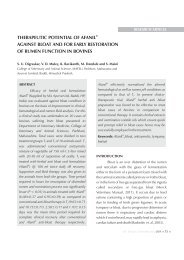morphological studies on the liver of sambar deer - Jivaonline.net
morphological studies on the liver of sambar deer - Jivaonline.net
morphological studies on the liver of sambar deer - Jivaonline.net
You also want an ePaper? Increase the reach of your titles
YUMPU automatically turns print PDFs into web optimized ePapers that Google loves.
RESEARCH ARTICLE<br />
MORPHOLOGICAL STUDIES ON THE LIVER OF<br />
SAMBAR DEER (Cervus unicolor)<br />
1 2 3<br />
A. R. Sreeranjini , C. V. Rajani and N. Ashok<br />
Dept <strong>of</strong> Veterinary Anatomy & Histology<br />
College <strong>of</strong> Veterinary & Animal Sciences, Mannuthy, Thrissur, Kerala.<br />
ABSTRACT<br />
The present study was c<strong>on</strong>ducted <strong>on</strong> <strong>the</strong> <strong>liver</strong> collected from three Sambar <strong>deer</strong>. The <strong>liver</strong> had an average<br />
weight <strong>of</strong> 1 kilogram and was firm and friable with reddish brown colour. It presented two surfaces and four borders.<br />
The cranial diaphragmatic surface was occupied by <strong>the</strong> falciform ligament, round ligament, right and left<br />
triangular ligaments and <strong>the</strong> area nuda which was bounded by <strong>the</strong> cor<strong>on</strong>ary ligament .The hepatic porta <strong>on</strong> <strong>the</strong><br />
visceral surface c<strong>on</strong>tained <strong>the</strong> hepatic artery, portal vein, hepatic duct and several hepatic lymph nodes. The line <strong>of</strong><br />
attachment <strong>of</strong> lesser omentum <strong>on</strong> <strong>the</strong> visceral surface was almost straight. The notch for round ligament was distinct<br />
and deeper. The thick dorsal border lodged <strong>the</strong> caudal vena cava and <strong>the</strong> oesophagial notch. The lobati<strong>on</strong> <strong>of</strong> <strong>liver</strong><br />
was more distinct than that <strong>of</strong> large ruminants. The left lobe was undivided but showed fissures and notches. The<br />
gall bladder and gall bladder fossa were not present. The quadrate lobe and <strong>the</strong> undivided right lobe were not<br />
clearly demarcated. The caudate lobe c<strong>on</strong>sisted <strong>of</strong> a small and more distinct papillary process and a large caudate<br />
process. The caudate process and <strong>the</strong> right lobe formed <strong>the</strong> deep renal impressi<strong>on</strong> for <strong>the</strong> cranial pole <strong>of</strong> right kidney.<br />
Key words: Morphology, Liver, Sambar <strong>deer</strong><br />
JIVA Vol. 9 Issue 1 April 2011<br />
INTRODUCTION<br />
Sambar <strong>deer</strong> is <strong>the</strong> largest <strong>of</strong> all <strong>deer</strong> species<br />
found in India. It is mainly a forest dweller that<br />
prefers hills and denser parts <strong>of</strong> <strong>the</strong> forest. It feeds <strong>on</strong><br />
leaves, wild fruits and grass. The coat colour is<br />
brown with grayish tinge. A fully grown <strong>deer</strong> attains<br />
about 300 kg body weight and reaches a height <strong>of</strong><br />
135 -150 cm at <strong>the</strong> shoulder. They are extremely shy<br />
<strong>of</strong> humans and feed during later evenings and in<br />
night. They are good swimmers and have very acute<br />
sense <strong>of</strong> hearing.<br />
Liver is <strong>the</strong> largest gland in <strong>the</strong> body. In<br />
foetus, it is an important haemopoietic organ. It is a<br />
storage organ <strong>of</strong> glycogen, fat and protein. The <strong>liver</strong><br />
secretes bile and c<strong>on</strong>verts end products <strong>of</strong> protein<br />
catabolism to urea and uric acid. It removes waste<br />
products resulting from <strong>the</strong> break down <strong>of</strong><br />
erythrocytes. It also plays an important role in <strong>the</strong><br />
detoxificati<strong>on</strong> <strong>of</strong> harmful substances. Literature<br />
pertaining to <strong>the</strong> gross anatomical <str<strong>on</strong>g>studies</str<strong>on</strong>g> <strong>on</strong> <strong>the</strong> <strong>liver</strong><br />
<strong>of</strong> Sambar <strong>deer</strong> was found to be scanty. Hence <strong>the</strong><br />
present study was undertaken.<br />
28<br />
MATERIALS AND METHODS<br />
The present study was c<strong>on</strong>ducted <strong>on</strong> <strong>the</strong> <strong>liver</strong><br />
collected from three Sambar <strong>deer</strong> brought for post<br />
mortem to <strong>the</strong> Department <strong>of</strong> Pathology at College <strong>of</strong><br />
Veterinary & Animal Sciences, Pookot, Wayanad.<br />
Various <str<strong>on</strong>g>morphological</str<strong>on</strong>g> features were studied and <strong>the</strong><br />
weight <strong>of</strong> <strong>the</strong> <strong>liver</strong> was taken with <strong>the</strong> help <strong>of</strong> an<br />
electr<strong>on</strong>ic balance.<br />
RESULTS AND DISCUSSION<br />
The <strong>liver</strong> was firm and friable with reddish<br />
brown colour and had an average weight <strong>of</strong> 1 kilogram.<br />
It presented two surfaces namely diaphragmatic and<br />
visceral surfaces and four borders viz. right, left, dorsal<br />
and ventral. The cranial diaphragmatic surface was<br />
c<strong>on</strong>vex and was related to <strong>the</strong> diaphragm. This surface<br />
presented <strong>the</strong> thin serosal sheet called falciform<br />
ligament which extended from <strong>the</strong> oesophagial notch to<br />
<strong>the</strong> notch for <strong>the</strong> round ligament (Fig.1). Dorso medially<br />
1 3<br />
Assistant Pr<strong>of</strong>essor, Pr<strong>of</strong>essor, Dept <strong>of</strong> Veterinary Anatomy &<br />
Histology, College <strong>of</strong> Veterinary & Animal Sciences, Mannuthy<br />
2<br />
Assistant Pr<strong>of</strong>essor, Dept <strong>of</strong> Veterinary Anatomy & Histology,<br />
College <strong>of</strong> Veterinary & Animal Sciences, Pookot, Wayanad, Kerala.
RESEARCH ARTICLE<br />
it is oblique (Getty 1975).<br />
The right border was short and thick as in<br />
ruminants. This border al<strong>on</strong>g with right lobe and<br />
caudate process presented <strong>the</strong> deep renal impressi<strong>on</strong><br />
for <strong>the</strong> right kidney. The left border was thin and<br />
c<strong>on</strong>vex and it c<strong>on</strong>nected <strong>the</strong> dorsal and ventral<br />
borders. The thin ventral border presented <strong>the</strong> notch<br />
for round ligament which was distinct and deeper as<br />
in hog <strong>deer</strong> (Jayathangaraj et. al., 2000). But in large<br />
ruminants this fissure is indistinct. The round<br />
ligament was present as a slight thickening <strong>of</strong> <strong>the</strong><br />
caudal free edge <strong>of</strong> falciform ligament and it<br />
represented <strong>the</strong> vestige <strong>of</strong> umbilical vein. In small<br />
ruminants it is not evident (Dyce et. al., 1996). The<br />
thick dorsal border lodged <strong>the</strong> caudal vena cava in<br />
<strong>the</strong> sulcus venae cavae. Medial to <strong>the</strong> sulcus venae<br />
cavae, <strong>the</strong> oesophagial notch was noticed at about<br />
<strong>the</strong> middle <strong>of</strong> this border unlike in ruminants where it<br />
is located more medially and to <strong>the</strong> left.<br />
Fig.1. Parietal surface <strong>of</strong> <strong>the</strong> <strong>liver</strong> <strong>of</strong> Sambar <strong>deer</strong><br />
L- Left lobe, R- Right lobe, Q- Quadrate lobe, Cp- Caudate process,<br />
F- Falciform ligament, Rl- Round ligament, Cl- Cor<strong>on</strong>ary ligament,<br />
Rt- Right triangular ligament.<br />
this surface presented a l<strong>on</strong>g triangular area without<br />
serosal covering, area nuda which was closely attached<br />
to <strong>the</strong> diaphragm as in o<strong>the</strong>r ruminants (Getty 1975).<br />
This area was bounded by <strong>the</strong> two divisi<strong>on</strong>s <strong>of</strong> cor<strong>on</strong>ary<br />
ligament. The right triangular ligament c<strong>on</strong>nected <strong>the</strong><br />
caudolateral angle <strong>of</strong> <strong>the</strong> <strong>liver</strong> to <strong>the</strong> dorsolateral<br />
abdominal wall. The left triangular ligament was<br />
noticed near <strong>the</strong> oesophageal notch and it c<strong>on</strong>nected <strong>the</strong><br />
<strong>liver</strong> to diaphragm. These two ligaments were<br />
c<strong>on</strong>nected by <strong>the</strong> narrow cor<strong>on</strong>ary ligament located <strong>on</strong><br />
<strong>the</strong> diaphragmatic surface lateral to <strong>the</strong> caudal vena<br />
cava. The hapato renal ligament was located medial to<br />
<strong>the</strong> right lateral ligament and c<strong>on</strong>nected <strong>the</strong> <strong>liver</strong> to <strong>the</strong><br />
anterior end <strong>of</strong> right kidney.<br />
The caudal visceral surface presented <strong>the</strong><br />
hepatic porta at about its middle (Fig.2). The hepatic<br />
porta presented <strong>the</strong> hepatic artery, portal vein, hepatic<br />
duct and several hepatic lymph nodes. The right and left<br />
hepatic ducts joined to form <strong>the</strong> comm<strong>on</strong> hepatic duct<br />
which opened in <strong>the</strong> duodenum. The line <strong>of</strong> attachment<br />
<strong>of</strong> lesser omentum extended from oesophagial notch to<br />
porta and was almost straight unlike in ruminants where<br />
Fig.2. Visceral surface <strong>of</strong> <strong>the</strong> <strong>liver</strong> <strong>of</strong> Sambar <strong>deer</strong> L- Left<br />
lobe, Q- Quadrate lobe, Pp- Papillary process, Cp- Caudate<br />
process, Hp- Hepatic porta, O- Oesophageal notch, Nr- Notch<br />
for round ligament, Lo- Lesser omentum, V- Vena cava.<br />
In <strong>deer</strong>, <strong>the</strong> lobati<strong>on</strong> <strong>of</strong> <strong>liver</strong> was more<br />
distinct as in small ruminants (Getty, 1975) and<br />
unlike in large ruminants (Fig.2). The left lobe <strong>of</strong> <strong>the</strong><br />
<strong>liver</strong> was located ventral to an imaginary line<br />
c<strong>on</strong>necting <strong>the</strong> oesophagealnotch and <strong>the</strong> notch for<br />
<strong>the</strong> round ligament. This lobe was undivided as in<br />
small and large ruminants, but it showed an arc like<br />
fissure at about <strong>the</strong> middle <strong>of</strong> its visceral surface.<br />
Ano<strong>the</strong>r 'L' shaped fissure was present <strong>on</strong> this lobe<br />
near <strong>the</strong> left border. Two sec<strong>on</strong>dary notches could<br />
also be noticed near <strong>the</strong> notch for <strong>the</strong> round<br />
JIVA Vol. 9 Issue 1 April 2011<br />
29
RESEARCH ARTICLE<br />
ligament. The gall bladder and gall bladder fossa<br />
were not present. Due to <strong>the</strong> absence <strong>of</strong> gall bladder<br />
and <strong>the</strong> notch <strong>on</strong> <strong>the</strong> ventral border separating <strong>the</strong><br />
quadrate and right lobes, <strong>the</strong>se two lobes were not<br />
clearly demarcated in <strong>the</strong> <strong>deer</strong>. The quadrate lobe<br />
was more distinct than that <strong>of</strong> large ruminants. The<br />
right lobe was undivided as in o<strong>the</strong>r ruminants. The<br />
caudate lobe c<strong>on</strong>sisted <strong>of</strong> a small papillary process<br />
projecting towards <strong>the</strong> porta and a large caudate<br />
process dorsal to <strong>the</strong> porta which protruded above <strong>the</strong><br />
right border. The papillary process was more distinct<br />
as in sheep (Nickel et. al., 1979) and unlike in large<br />
ruminants. The caudate process presented a fissure at<br />
<strong>the</strong> dorsal end and was narrower and less blunt as in<br />
small ruminants (Dyce et. al., 1996). The caudate<br />
process and <strong>the</strong> right lobe formed <strong>the</strong> deep renal<br />
impressi<strong>on</strong> for <strong>the</strong> cranial pole <strong>of</strong> <strong>the</strong> right kidney.<br />
REFERENCES<br />
Dyce, K. M., Sack, W. O., and Wensing, C. J.G. (1996).<br />
nd<br />
Textbook <strong>of</strong> Veterinary Anatomy, 2 edn. W. B.<br />
Saunders Company, Philadelphia. pp: 62-64.<br />
Getty, R. (1975). Siss<strong>on</strong> and Grossman's The Anatomy <strong>of</strong> The<br />
th<br />
Domestic Animals. Vol. II, 5 edn. W. B. Saunders<br />
Company, Philadelphia. pp: 1473-1474.<br />
Jayathangaraj, M. G., John, M. C., Ushakumari, S. and<br />
Sathyamoorthy, O. R. (2000).Comparis<strong>on</strong> <strong>of</strong><br />
macroscopic anatomy <strong>of</strong> <strong>liver</strong>, spleen and kidney <strong>of</strong><br />
hog <strong>deer</strong> with <strong>the</strong> respective organs in sheep. In:<br />
Proceedings <strong>of</strong> XV c<strong>on</strong>venti<strong>on</strong> <strong>of</strong> Indian Associati<strong>on</strong><br />
<strong>of</strong> Veterinary Anatomists and Nati<strong>on</strong>al Symposium.<br />
December 23-25, 2000. MadrasVeterinaryCollege,<br />
Chennai.<br />
Nickel, R., Schummer, A. and Seiferle, E. (1979).The viscera<br />
nd<br />
<strong>of</strong> <strong>the</strong> domestic mammals.2 edn, Verlag Paul<br />
Parey, Berlin, Hamburg. pp: 81-85.<br />
INFOMANIA<br />
JIVA Vol. 9 Issue 1 April 2011<br />
This set <strong>of</strong> questi<strong>on</strong>s relate to foods<br />
1. Name <strong>the</strong> art and science <strong>of</strong> good eating or <strong>the</strong> study <strong>of</strong> food and culture .<br />
2. Which is <strong>the</strong> fifth basic taste apart from bitter, salty, sweet and sour. It is described as a meaty taste with l<strong>on</strong>g lasting,<br />
mouth watering and coating sensati<strong>on</strong> over <strong>the</strong> t<strong>on</strong>gue.<br />
3. Name <strong>the</strong> subjective scale used for organoleptic evaluati<strong>on</strong> <strong>of</strong> spiciness <strong>of</strong> pepper and chilli.<br />
4. Ageusia means<br />
5. To <strong>the</strong> c<strong>on</strong>sumpti<strong>on</strong> <strong>of</strong> which substance, <strong>the</strong> Chinese Restaurant Syndrome has been associated.<br />
6. Name <strong>the</strong> n<strong>on</strong> ficti<strong>on</strong> book authored by Michael Pollan in 2006 which describes <strong>the</strong> human food choices.<br />
7. Describe pescetarianism.<br />
8. How do we define a set <strong>of</strong> cooking traditi<strong>on</strong>s and practices <strong>of</strong>ten associated with a specific culture and are<br />
influenced primarily by <strong>the</strong> locally available ingredients and are named according to <strong>the</strong> regi<strong>on</strong>.<br />
9. This was popularised in Kerala during <strong>the</strong> 80's.It c<strong>on</strong>sists <strong>of</strong> shavings <strong>of</strong> <strong>the</strong> roasted meat with vegetables from a<br />
skewer, and is covered with a bread. Eaten with sauce .Identify this fast food.<br />
10. Name <strong>the</strong> ice cream dessert, which usually has a scoop <strong>of</strong> ice cream with toppings including sauce, syrup, nuts, etc.<br />
11. Roti prata is a popular food in Singapore and shares many things in comm<strong>on</strong> to a Kerala food. Which is <strong>the</strong> Kerala<br />
food.<br />
12. What is <strong>the</strong> term for a young chicken,28 days old at slaughter, weighing 400-450 grams, but not more than<br />
750grams.Its syn<strong>on</strong>ym is spring chicken.<br />
13. Gustati<strong>on</strong> , <strong>the</strong> o<strong>the</strong>r comm<strong>on</strong>ly used word for this is<br />
14. What is <strong>the</strong> study <strong>of</strong> wine making named except vine growing and grape harvesting.<br />
15. Study <strong>of</strong> <strong>the</strong> effects <strong>of</strong> food <strong>on</strong> gene expressi<strong>on</strong> .<br />
Compiled by : Dr. Jayesh.V, Veterinary Surge<strong>on</strong>, District Veterinary Center, Kalpetta,Wayanad<br />
(comment at : jayeshvet@gmail.com)<br />
Answer - Page 41<br />
30



